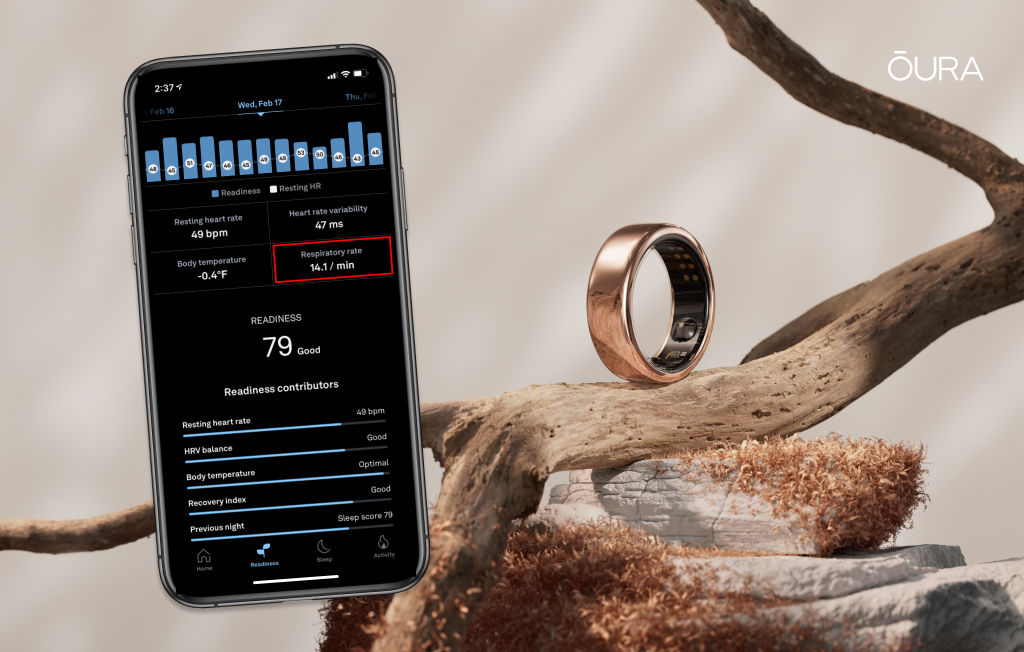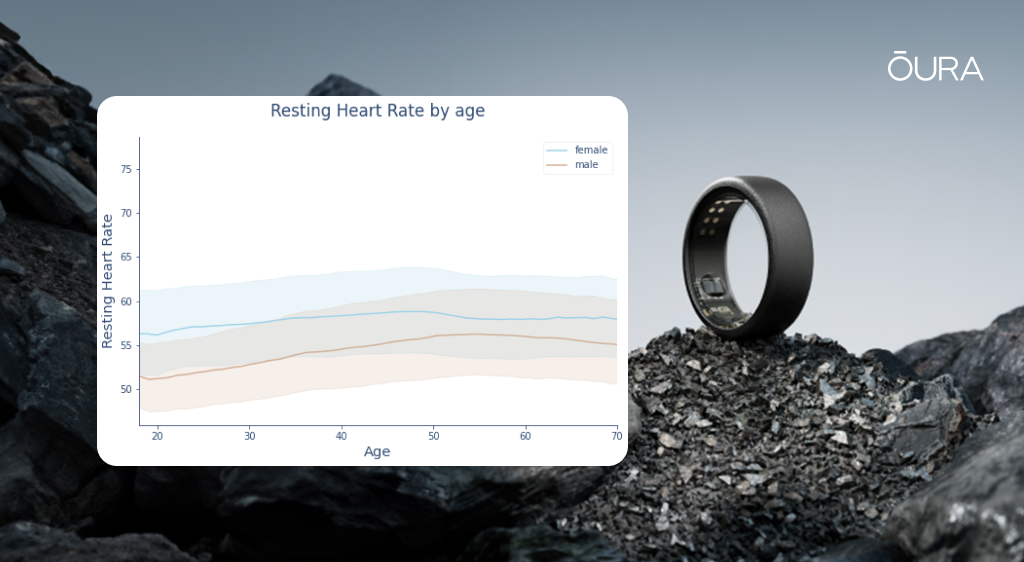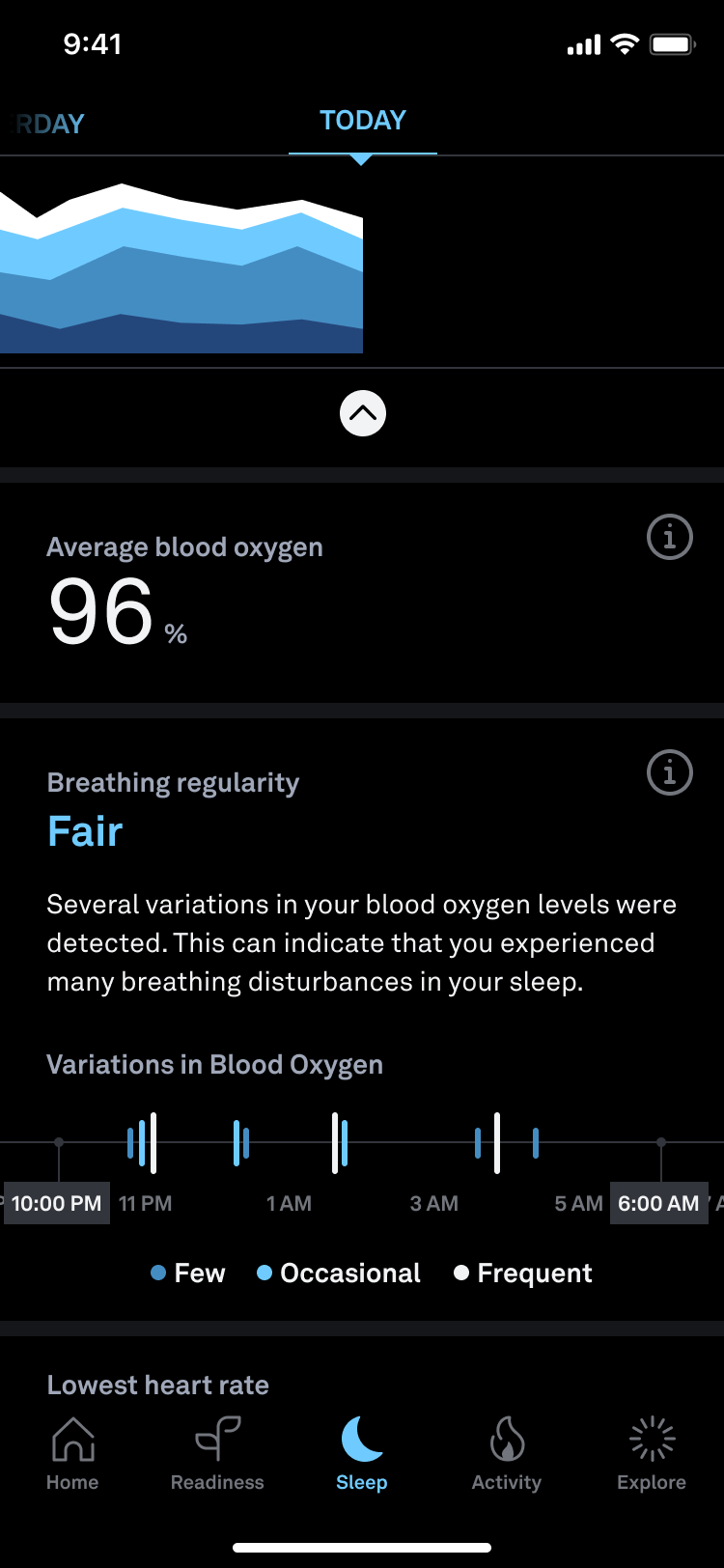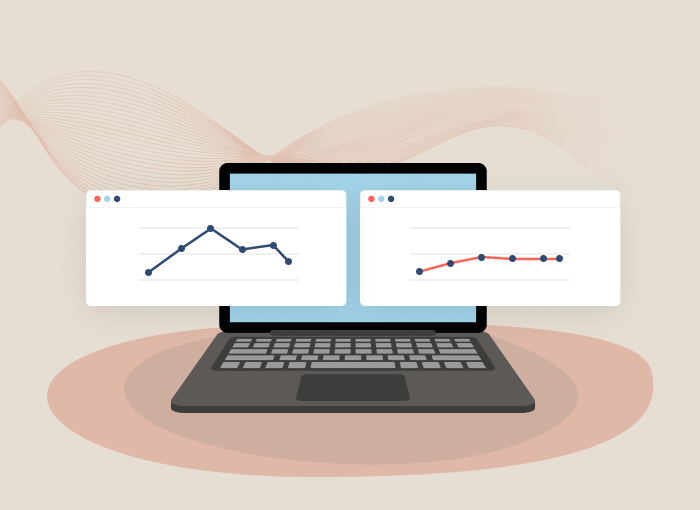- Your heart rate and respiratory rate have a bidirectional relationship, meaning: When you breathe in, your heart rate increases, and when you breathe out, your heart rate slows down.
- Various factors can impact your heart rate and breathing rate, including your age and gender, fitness level, environmental factors, illness, and medical conditions.
- You can use Oura to accurately monitor your heart rate and respiratory rate to spot changes from your normal levels that could indicate a change in your health. Gain further insights into your overall heart health by using Oura’s new heart health features: Cardio Capacity and Cardiovascular Age.
While numerous factors contribute to your overall well-being, two fundamental components include the health of your heart, as well as your respiratory rate.
One metric that provides insight into the health of your heart is your heart rate, or the number of times the heart beats per minute. This measures the rate at which blood is circulated throughout the body.
Oura accurately monitors your heart rate 24/7, which you can find in your the Heart Rate Graph in the Home tab of the Oura App. There, you’ll find color-coded visualizations of your sleeping, daytime, and workout heart rates, as well as periods of Restorative Time, all in the same chart. Now you can gain further insights into your heart health by using Oura’s new heart health features: Cardio Capacity and Cardiovascular Age.
Another major system in your body is the respiratory system, which supplies the body with essential oxygen. Your breathing rate, or your respiratory rate, refers to the number of breaths taken per minute, indicating the rate at which you inhale oxygen and exhale carbon dioxide. In the Oura App, you can find your nighttime respiratory rate (the average number of breaths you take per minute) in your Readiness Tab.
READ MORE: How Accurate Are Oura’s Respiratory Rate Measurements?

Understanding Respiratory Sinus Arrhythmia
In the Oura App, your respiratory rate is calculated via minute-by-minute changes in your nighttime heart rate. This calculation is possible because your heart and lungs are closely connected by a process called respiratory sinus arrhythmia (RSA).
While the term arrhythmia may set off a mental alarm, RSA is actually a perfectly normal process and is a sign of a healthy heart. The process consists of the following:
- When you breathe in, your heart rate increases.
- When you breathe out, your heart rate slows down.
RSA is driven by the intricate interplay between heart rate and the autonomic nervous system — which consists of the sympathetic nervous system and the parasympathetic nervous system — during inhalation and exhalation.
When you breathe in, the sympathetic division of the autonomic nervous system (fight or flight mode) is activated. This activation leads to a slight increase in heart rate, preparing your body for increased oxygen demand. Conversely, as you breathe out, the parasympathetic division (rest and digest mode) takes over, triggering a decrease in heart rate, and promoting relaxation and restoration.
The dynamic interplay between the sympathetic and parasympathetic activations not only facilitates the synchronization of heart rate and breathing rate, but also promotes optimal oxygenation. This ensures that blood flow to the lungs increases during inhalation, enhancing the efficiency of oxygen exchange.
This rhythm between the autonomic nervous system, heart rate, and respiratory rate supports your overall health and oxygen balance. As such, it’s important to keep both heart rate and breathing rate stabilized, as any imbalances or disruptions can have implications for your physiological functioning.
5 Factors That Affect Heart Rate and Breathing Rate
1. Your Age & Gender
Resting heart rate and breathing patterns vary across individuals. Your personal characteristics can impact your heart rate and breathing rate.
Younger individuals typically exhibit lower resting heart rates and more efficient breathing. Oura data backs that up: An analysis of Oura members’ resting heart rates shows that on average, resting heart rate increases slightly until around the ages of 50-60, after which it levels off and may even decrease slightly.
Additionally, there is a difference in average resting heart rates between female and male Oura members. With an average of 58.1 beats per minute, women tend to have slightly higher resting heart rates compared to men, who average 54.5 beats per minute. This difference can be attributed to the female heart being smaller. Since a smaller heart pumps less blood with each beat, it compensates by beating at a faster rate to match the larger heart’s output.

Plus, women’s respiratory rates typically vary more due to a link between changes in respiratory rate and menstrual cycle stages. Respiration is slower at the start of the cycle (follicular phase), increasing as the cycle comes to an end (luteal phase).
2. Your Fitness Level
Regular physical activity and cardiovascular fitness can also contribute to a lower resting heart rate and optimized breathing rate. In contrast, sedentary lifestyles or age-related changes may lead to higher resting heart rates and altered breathing patterns.
This is because engaging in regular cardio and other physical activity strengthens the heart, enabling it to pump blood more efficiently. As a result, the heart doesn’t have to work as hard, leading to a lower resting heart rate. In addition, regular physical activity improves lung function, which, in turn, contributes to an optimized breathing rate and improved oxygen exchange.
3. Environmental Factors
Various environmental factors, including temperature, air quality, and altitude can impact heart rate and breathing rate. In hot weather, for instance, the body’s cooling mechanism kicks in, leading to an increase in heart rate and respiratory rate as it works hard to regulate temperature.
Similarly, poor air quality, such as high pollution levels, can have an impact on blood oxygen levels. When exposed to pollutants in the air, the respiratory system may struggle to extract sufficient oxygen from the inhaled air, leading to lower oxygen levels in the bloodstream. This decrease in blood oxygen levels triggers a response from the body, causing an increase in breathing rate and potentially elevating heart rate as well.
 Oura detects blood oxygen saturation levels (SpO2) and variations during sleep, offering insights into your body’s oxygen absorption and circulation. It also detects breathing disturbances that may occur while you sleep, providing you with a better understanding of your overall health.
Oura detects blood oxygen saturation levels (SpO2) and variations during sleep, offering insights into your body’s oxygen absorption and circulation. It also detects breathing disturbances that may occur while you sleep, providing you with a better understanding of your overall health.
At high altitudes, oxygen levels decrease, prompting the body to compensate by raising both heart rate and respiratory rate. So don’t fret if your heart rate increases when you visit (or live in) a higher elevation.
Case in point: Endurance runner and Oura member Don Reichelt shared that he sees a higher heart rate living at an altitude of 10,000 feet than he would at sea level: “So, my resting heart rate is a little higher than it would be at sea level. For example, last night, my lowest resting heart rate was 44. If I go down to sea level, it’s usually around 36,” he says.
4. Illness
As your body fights off an infection, it triggers various physiological changes, such as increased body temperature, inflammation, or the release of certain hormones. These changes lead to an elevated heart rate, which in turn, stimulates an increase in respiratory rate to support oxygen delivery and maintain proper gas exchange.
In fact, Oura data shows that members’ resting heart rates increase by an average of 8.5 bpm when they tag “fever” or “flu.”
LEARN MORE: Why Is My Heart Rate Higher When I’m Sick?
In the case of a respiratory tract infection like bronchitis, the increase in breathing rate is also because the infection causes temporary damage inside your lungs. This damage affects the cells responsible for exchanging oxygen and carbon dioxide. As a result, you need to breathe faster to compensate for the reduced efficiency in getting oxygen into your bloodstream.
It’s important to note that the specific effects on respiration rate during sickness can vary depending on the type and severity of the illness, as well as individual factors. If you’re experiencing respiratory distress or have concerns about your breathing while sick, it’s advisable to consult a healthcare professional for proper evaluation and guidance.
5. Medical Conditions
Certain medical conditions can significantly impact heart rate and breathing rate. For example, asthmatic people may experience elevated heart rates and rapid breathing during asthma attacks or periods of restricted airflow.
Conditions that impact the heart, like heart disease, can lead to irregularities in heart rate and potentially disrupt the typical patterns of respiratory sinus arrhythmia. Furthermore, chronic respiratory conditions such as chronic obstructive pulmonary disease (COPD) can affect breathing rate, which in turn can have an impact on heart rate.
Oura Trends and Readiness Score are powerful features that can help you track factors like heart rate and breathing rate to see if they can reveal anything about your overall health. For Oura member Mark C., an uncharacteristically high heart rate helped him realize that something may be wrong.
“I had my wife drive me to the emergency room after seeing the data. I was admitted to the hospital and ultimately diagnosed with Atrial Flutter,” says Mark. Thanks to the timely data, the doctors were able to correct the heart condition.
“[Oura] quite literally may have saved my life…Thank you for creating such an amazing product,” Mark told us.
RELATED: All About Cardiovascular Age
3 Techniques to Regulate Heart Rate and Breathing Rate Levels
Certain medical conditions and everyday stressors can disrupt heart rate and breathing rate, but there are effective techniques to help restore balance.
1. Deep Breathing Exercises
Deep breathing exercises can be a valuable tool in regulating heart rate and breathing rate. By consciously taking slow, deep breaths, you can activate the parasympathetic nervous system, which helps to slow down the heart rate and establish a more balanced breathing pattern.
RELATED: 5 Simple Breathing Techniques for a Good Night’s Sleep

2. Meditation and Mindfulness
Meditation and mindfulness practices have been shown to have a positive impact on heart rate and breathing rate regulation. By focusing on the present moment and cultivating a sense of calm, meditation and mindfulness can help you achieve a state of deep relaxation, leading to a decrease in heart rate and a more efficient breathing pattern.
If you’re an Oura member, you can use the Oura App to access Explore content to access a library of both guided and unguided meditation content. You’ll also get some post-session biofeedback to help you see how your body responds to different types of meditation sessions.
3. Physical Activity and Exercise
Engaging in regular physical activity and exercise is crucial for maintaining cardiovascular health and optimizing heart rate and breathing rate. As mentioned earlier, exercise strengthens the heart and reduces resting heart rate over time. Physical activity also enhances lung capacity and improves the overall efficiency of the respiratory system.
Aerobic or cardio exercises, such as running, swimming, or cycling, are particularly effective in training the cardiovascular system and promoting optimal heart rate and breathing rate.
READ MORE: Defining Low, Medium, and High-Intensity Movement & Using Oura to Track It





